People
With a New Show in London, Painter Daniel Richter Talks Political History, German Identity, and Ugandan Dance Music
The artist's solo exhibition "Stupor" is on view at Thaddaeus Ropac until December 1, 2023.
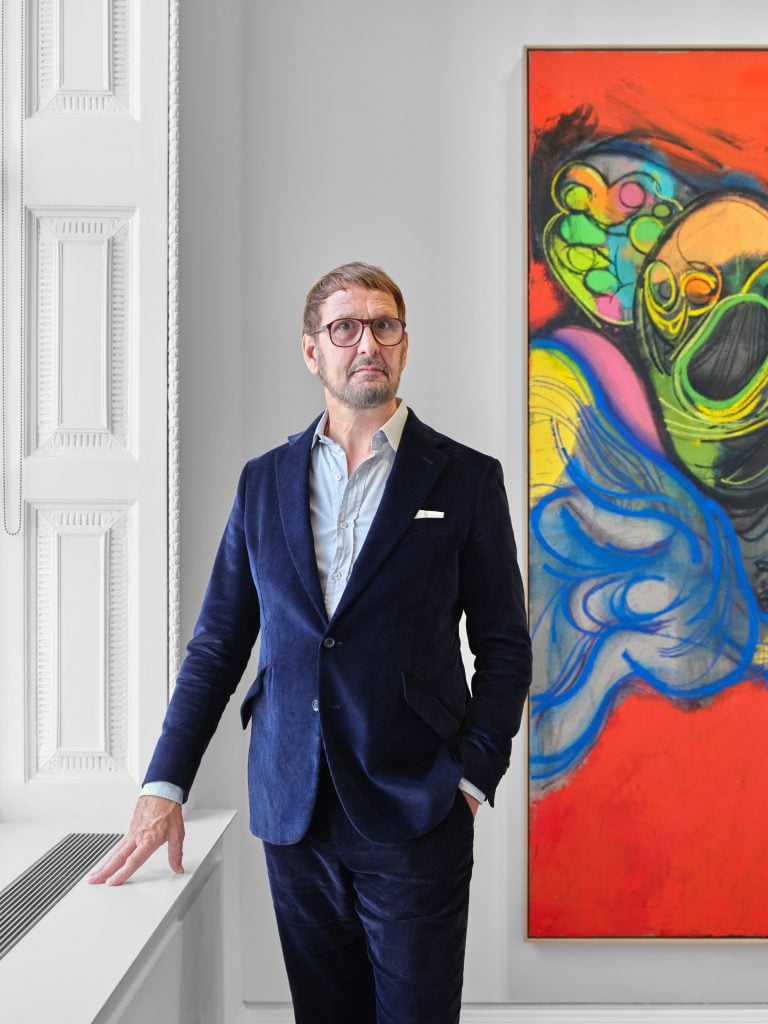
The artist's solo exhibition "Stupor" is on view at Thaddaeus Ropac until December 1, 2023.

Kate Brown

The Metropol theater, a muscular relic of Art Nouveau decadence in Berlin’s Schoneberg district, looms beyond the window of Daniel Richter’s studio, taking up most of the visible skyline. The studio is modest in size for an artist of Richter’s stature: it is not buzzing with artist assistants and interns, and it is no lofty warehouse. Wide stacks of catalogs stand behind his desk which looks out onto a wall where three large paintings hang. Before them is one paint-splotched yoga mat.
“The bigger the space gets the more people you need working for you,” Richter notes, sitting framed by a pot of herbal tea and a small bowl of nuts. “If I moved to a hangar, my paintings would look like stamps. I do not want to make seven meters painting. I want to stay solitary in this mix of music and literature, in a situation I can control.”
Richter’s paintings in the studio are still an impressive scale, just over two meters in height, large but not too large so as to not be able to fit out the studio door. They are curiously alluring, with brazen constellations of color and a nearly impeccable sense of negative space to balance it. The studio is usually filled with music played from his formidable record collection; he used to have the company of two green parrots, but they became violent with visitors, so he had to find a new home for them. A day in the studio starts late and ends late. “I listen to music; I nag around; I feel insecure; I hide that; I listen to music again. I brood a lot, it is an important part of the painterly process. I make mistakes, but the next day, mistakes can be used in other paintings. That’s it. It’s oil on a canvas.”
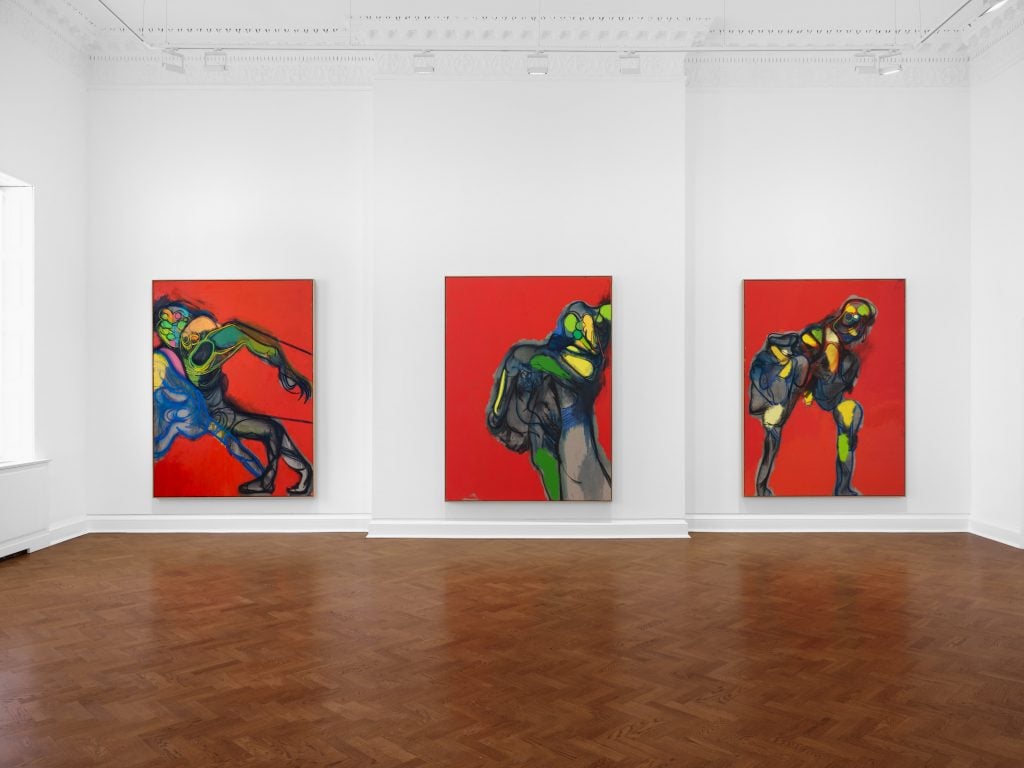
Image credits: Daniel Richter, “Stupor.” Installation view. Thaddeus Ropac, London (October 10—December 1, 2023). Courtesy Thaddeus Ropac gallery, London, Paris, Salzburg, Seoul. Photo: Eva Herzog.
He has a dry wit that never seems to be too far from anything he articulates and he seems keenly aware of the many contradictions that come with becoming a market star, an artist part of the German painter mythos, and just a cultured person in general. “There are cliches about the art world, and most of them are true,” he notes when I bring up the fact of the market. “You also must admit that in this world you do get to meet a lot of interesting people.” The conversation moves on.
He’d rather focus on talking about things he likes. And, anyway, he notes the relatively small sphere of influence one gets to have when trying to call out the art world for anything. “Only those people will listen to you,” he shrugs. “And then they will invite you to dinner, and smear you with caviar and champagne—not Veuve Cliquot but Moet Chandon. And you’re fucked.”
Since Richter got his start in the early 1990s, moving to fine art after some years creating posters and album covers in the underground music scene, he flew for a time under the wing of Werner Büttner, his professor at the Hamburg University of Fine Arts. He lists Martin Kippenberger and Albert Oehlen as two other key mentors from that time. Kippenberger remained a friend until his death. Oehlen is a close confidant. Richter and his good friend, the painter Jonathan Meese, who also went to the same school, are often argued as two among a cohort of painterly successors to the Kippenberger irreverent generation, matching it in tone though moving it forward in their styles.
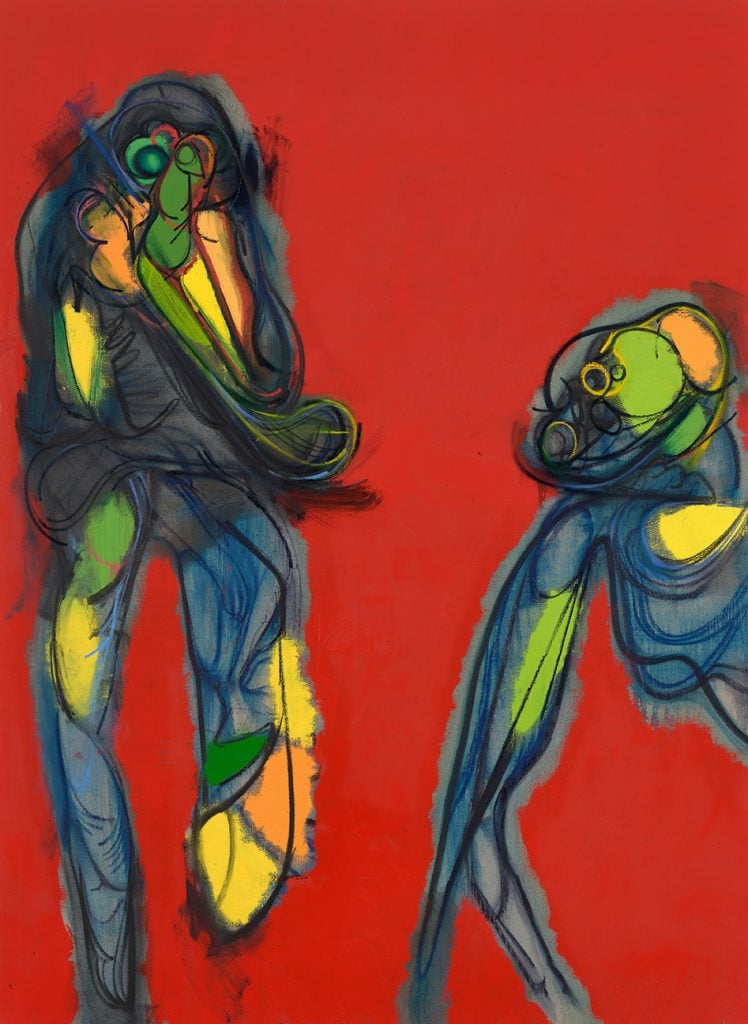
Jahresdaten meiner Langeweile (2023). Courtesy Thaddeus Ropac gallery, London, Paris, Salzburg, Seoul. Photo: Eva Herzog.
Richter’s latest bodies of work dance a fine line between abstraction and representation. At his show “Stupor,” which opened at Thaddaeus Ropac in London during Frieze week, a series of works, tightly linked paintings, flirt with figuration. Your eye might seek out the shape of a four-legged creature in Kunterbunte Kettenhunde (translated to “motley chain dogs”) but it teeters on an edge—and you would be missing the point to pin it down as such. Still, the titles dare us to do so, while eschewing easy interpretation. Dentäre und Dioten (translated to “dentaries and dictators”) contains two form-like clusters with a deep scarlet red background that binds whatever their fates might be. In this newest phase, it is as though figures were once part of the idea before Richter ran them through metaphoric sieves, again and again, until just the spirit of those forms were left. They cascade around in rich colors, moving in and out of our focus.
“It is hard in the case of painting non-representative work to explain why we like one work more than another,” says the artist. “What are the vectors to describe why a painting works? Opacity, dynamics? That is something that interests me.” His most current phase sees the two walk the tightest rope between figuration and abstraction yet. Other recent exhibitions include Camden Arts Center, London, the Louisiana Museum, and Whitechapel.
Over the years, Richter has changed course more than most painters, but he has never wandered into sculpture, like so many artists do, including his own mentors, like Oehlen. Büttner even momentarily dabbled there. In fact, it seems that most painters who reach a certain level of career are tempted to try out working something grandiose into bronze, or creating a sculptural derivative of their painted subjects in wood, and so on.
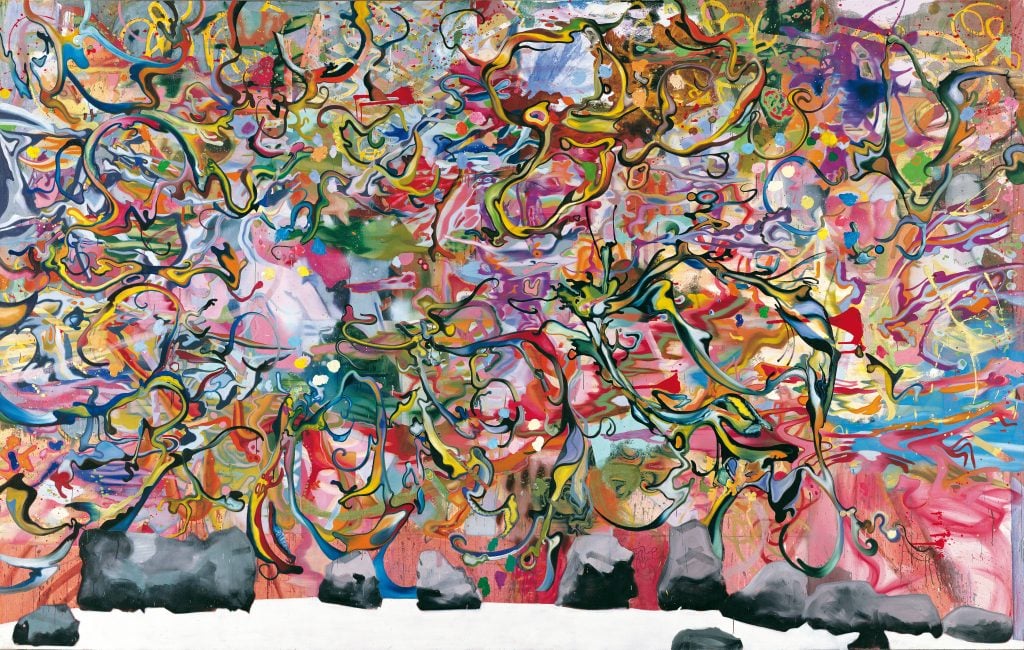
Daniel Richter Fool on a Hill (1999). Courtesy Galerie Thaddaeus Ropac, London, Paris, Salzburg, Seoul. © Daniel Richter / VG Bildkunst, Bonn 2023. Photo: farbanalyse.
“Traitors!” he cries out when I ask him why he has never pursued sculpture like others. Just as he did for offers to scale up his studio, he has similarly rejected commissions to make sculptures. “There are some artists for whom it makes sense, like Georg Baselitz, but there are others, who I will not name, where I think it is just vanity,” he notes. “Maybe there are genius sculptures in me, but we will never find out. I will be on my death bed, maybe, and then maybe I will have a revelation.”
Perhaps a key reason he has not strayed into it is also that he has continued to challenge himself through various artistic phases. In his recent retrospective at at Kunsthalle Tübingen, one can see this oscillation across the years. He began his artistic career with vibrant and wild abstraction—these works from the early to mid-1990s contain so much color and form that they become almost kaleidoscopic or psychedelic; still, this body of work has two feet planted in modernist and expressionist traditions. A close friend of Richter, the Danish painter Tal R, aptly described the tension: “The paintings would always try to kill him. He would put in so many details, but the painting would seem to say ‘I can take more, is that all you got?’”
Richter does not disagree. “I know that my paintings are not very subtle,” he says. “There is something cowardly about subtlety. I tend to overload.” That vigor has been maintained throughout his development through various styles. He flipped a switch around 1999 and, increasingly, discernible figures stepped out into the frame. Two extra-large paintings (at the time, he had a big studio in a defunct post office in former East Berlin) come to mind. There was Phienox, from 2000, which speaks at one level to the fall of the Berlin Wall in 1989—it seems to show people taking apart a barrier. However, the image itself is a direct reference to photographs taken in the wake of a terrorist attack in Germany.
Or there is the critically acclaimed Tarifa, from 2001, showing a group afloat on a raft. The gaze of the painting is both compassionate and sinister. In this era of work, lines and color radiate out from bodies like a thermal-imaging camera; each person becomes an aura of themselves, somewhat holy, but also a suspect and a target.
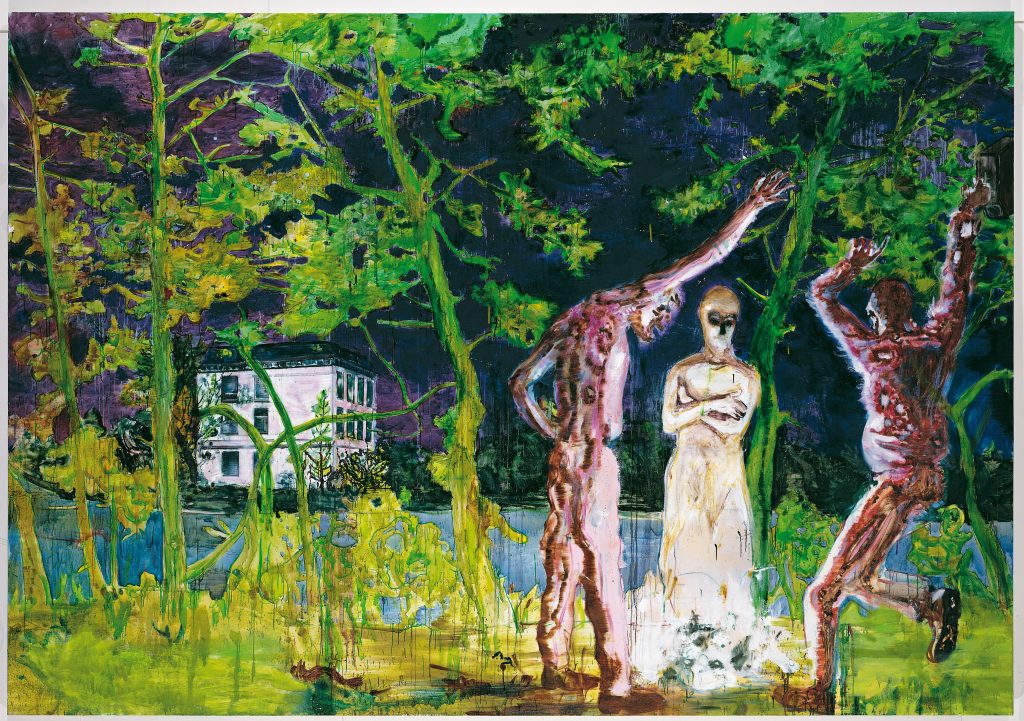
Daniel Richter Billard um halbzehn (2001). Courtesy Galerie Thaddaeus Ropac, London, Paris, Salzburg, Seoul. © Daniel Richter / VG Bildkunst, Bonn 2023. Photo: farbanalyse.
Many know Richter best for that mid-career phase wading most directly into politics, generating the works based on imagery and photographs found in newspapers. But even then, the point was still not to draw straight lines to certain issues. “I would rather relate it to language than music,” he says, citing Chicago’s International Anthem and Nyege Nyege tapes from Uganda. (There is a room to the side filled floor to ceiling with records and lined with carpets.) “That is great music because all these elements work together: the experiment, the knowledge of history, radical, or political attitudes. But it is not all upfront. It is not an illustration of that, it is not a marching band.”
In fact, Richter comes from a political background; he was active in the leftist group Antifa in his stomping ground of Hamburg (he is from a small town north of Hamburg). Those politics—he is thankful, he says, that no one in his cohort became successful revolutionaries as planned—seem to still be within him, if not as explicitly in the work. In general, he sounds like he doesn’t need artists to be advocates, a prevalent trend in the art world. “When I want to learn something about history or language, I prefer to read theorists,” he says. “I don’t necessarily need artists. I do not necessarily need artists to be my preachers.”
So what is the allegorical red thread that one can trace through the work? Maybe it is the “German painter” personage that he’s a part of, like it or not. The lineage, however broken across styles and time and political divides, is one that you can trace from Sigmar Polke to Georg Baselitz to Neo Rauch. Again, he shrugs. “I didn’t know I was a ‘German painter,’ until I found out,” he admits. “It is embedded in thought constructions. When I went to England and America and met colleagues, I realized that they were reasoning very differently. At some point, you find out that you are based in a social or ideological construction and it is not something that you just take off like a coat.”
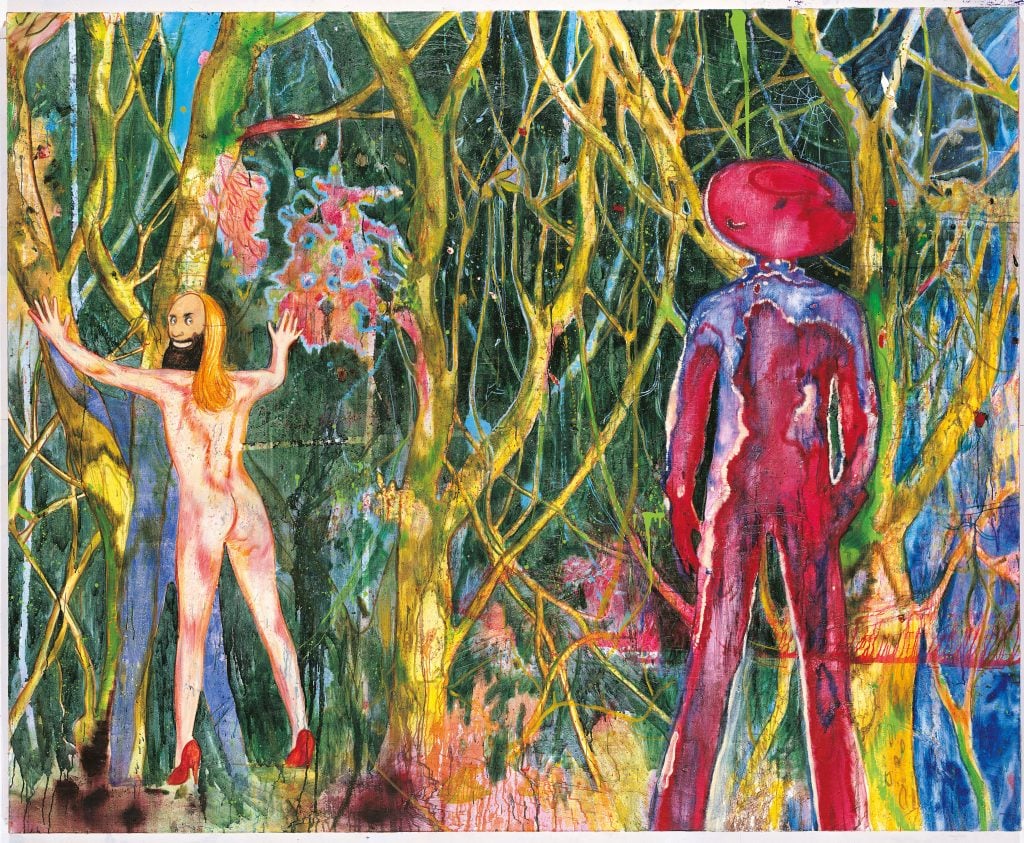
Daniel Richter Das erstaunliche Comeback des Dr. Freud (2004). Courtesy Galerie Thaddaeus Ropac, London, Paris, Salzburg, Seoul © Daniel Richter / VG Bildkunst, Bonn 2023.
German postwar painting in particular has a certain disdain for easily digestible beauty. Richter muses about it, noting a certain boldness, weirdness, and neuroticism. It can be hard to escape that origin story, especially when it just emanates off the tip of your brush. “I don’t like to admit it, but at some point in your life you look at your stuff and you see the main line, the main feeling about it. It’s the soil and it’s shit and you stink of it,” he says of his German identity. Even subculture and alternative scenes are still “perverted versions” of that same culture, he notes.
“And you think of yourself as a beautiful flower, but you come from that same shitty soil,” he says. “At some point you just accept it, like in psychotherapy—you just have to accept who you are.”
More Trending Stories:
Four ‘Excellently Preserved’ Ancient Roman Swords Have Been Found in the Judean Desert
